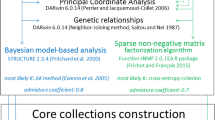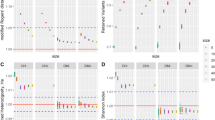Summary
The concept of core collections as developed by Brown (1989a) would be very useful in optimizing conservation strategies of natural population of outbreeding grasses. The aim of a core is to represent, in a subsample of manageable size, as much as possible of the genetic variation from a large collection. In the case of natural populations of ryegrass, different methods of stratified sampling with one level of classification have been compared:
-
1.
Random sampling.
-
2.
Clustering based on agronomic traits.
-
3.
Clustering based on the administrative region of origin.
-
4.
Clustering based on agronomic traits with geographic contiguity constraint.
This last method is based on geostatistics analysis, which allows to study the spatial pattern of genetic diversity. Ryegrass populations show for many agronomic traits a spatial structure of range 120 km, which could be attributed to the isolation-by-distance phenomenon. This range was used as a constraint for clustering populations based on multisite evaluation data.
The results show that, in a species like perennial ryegrass, a random sample of 5% of the accessions maintains 86% of the diversity. Core samples of 10% as recommended by Brown (1989b) enhance the representation to more than 90%. The use of stratified sampling methods is always more efficient than random sampling. The clustering based on geostatistics gives the best results with 92% of the variation being maintained in a 5% core collection.
Similar content being viewed by others

References
Balfourier F. & G. Charmet, 1991. Relationships between agronomic characters and ecogeographical factors in a collection of French perennial ryegrass populations. Agronomie 11:645–657.
Brown A.H.D., 1989a. The case for core collections. In; A.H.D. Brown, O.H., Frankel, D.R. Marshall & J.T. Williams (Eds) The use of plant genetic resources. Cambridge University Press, Cambridge, pp 136–156.
Brown A.H.D., 1989b. Core collections: a practical approach to genetic resources management. Genome 31:818–824.
Charmet G., F. Balfourier & A. Bion, 1990. Agronomic evaluation of a collection of French perennial ryegrass populations: multivariate classification using genotype x environment interactions. Agronomic 10:807–823.
Charmer G., F. Balfourier & C. Ravel, 1993. Isozyme polymorphism and geographic differentiation in a collection of French perennial ryegrass populations. Genetic Resources and Crop Evolution 40:77–89.
Charmet G., F. Balfourier & P. Monestiez, 1994. Hierarchical clustering of perennial ryegrass populations with geographic contiguity constraint. Theor. Appl. Genet. 88:42–48.
Crossa J., C.M. Hernandez, P. Bretting, S.A. Eberhart & S. Taba, 1993. Statistical genetic considerations for maintaining germplasm collections. Theor. Appl. Genet. 86:673–678.
Frankel O.H., 1984. Genetic perspectives of germplasm conservation. In; W. Arber, K. Llimensee, W.J. Peacock & P. Starlinger (Eds) Genetic manipulation: Impact on man and society. pp 161–170. Cambridge University Press, Cambridge UK.
Hutcheson K., 1970. A test for comparing diversities based on the Shannon Formula. J. Theor. Biol. 29:151–154.
Kimura M. & J.F. Crow, 1964. The number of alleles that can be maintained in a finite population. Genetics 49:725–738.
Monestiez P., M. Goulard & G. Charmet, 1994. Geostatistics for spatial genetic structures: study of wild populations of perennial ryegrass. Theor. Appl. Genet. 88:33–41.
Peeters J.P. & J.A. Martinelli, 1989. Hierarchical cluster analysis as a tool to manage variation in germplasm collections. Theor. Appl. Genet. 78:42–48.
Peeters J.P., H.G. Wilkes & N.W. Galwey, 1990. The use of ecogeographical data in the exploitation of variation from gene banks. Theor. Appl. Genet. 80:110–112.
Spagnoletti Zeuli P.L. & C.O. Qualset, 1993. Evaluation of five strategies for obtaining a core subset from a large genetic resource collection of durum wheat. Theor. Appl. Genet. 87:295–304.
Author information
Authors and Affiliations
Rights and permissions
About this article
Cite this article
Charmet, G., Balfourier, F. The use of geostatistics for sampling a core collection of perennial ryegrass populations. Genet Resour Crop Evol 42, 303–309 (1995). https://doi.org/10.1007/BF02432134
Received:
Accepted:
Issue Date:
DOI: https://doi.org/10.1007/BF02432134



